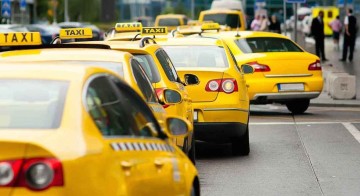Convenient services like Uber aggravate traffic jams, taking passengers from public transport
 Tax services of the new generation of Yaroslav Uber and Yandex.Taxi are much cheaper and more convenient than conventional dispatch stations, which used to take orders over the phone. Now you can know in advance the exact cost of the trip, see the route, drop a friend along the way and share payment with him, pay directly from the phone, etc. In general, taxi has become really more convenient. And cheaper.
Tax services of the new generation of Yaroslav Uber and Yandex.Taxi are much cheaper and more convenient than conventional dispatch stations, which used to take orders over the phone. Now you can know in advance the exact cost of the trip, see the route, drop a friend along the way and share payment with him, pay directly from the phone, etc. In general, taxi has become really more convenient. And cheaper.Since its inception, Uber and other similar services have promised not only low prices and convenience, but also reduce traffic jams. They argued that some motorists would give up personal transport in favor of a convenient and cheap taxi, where you don’t have to turn the steering wheel yourself in a tense posture with full concentration. Unfortunately, the harsh statistics convincingly shows the opposite: in those cities where tax service of the new generation began, traffic jams increased .
As shown by several studies, motorists for some reason did not get into a taxi. But who moved - so are cyclists, pedestrians and passengers of public transport .
As part of one study for the four weeks in Boston, at the end of 2017, 944 passenger ride-hailing taxis were surveyed. About 60% of them said they would go by public transport, bicycle, walk, or even cancel the trip if the application for an online taxi call was not at hand.
')
This study also showed that the absolute majority of passengers do not use a taxi to get to the nearest metro station or bus stop, but prefer to ride it to the very end of the route.
Probably, initially cheap tax services did not plan to compete with public transport, but wanted to complement it - mainly on such routes that the metro and other OT do not take. It turns out the opposite. Taxi services are de facto increasingly competing with public transport. It's funny that just recently Uber launched the cheap express-sharing ray-sharing Sharing Pool , where passengers, who follow a roughly identical route , get hooked into the same car at the stops . Here the analogy with public transport becomes quite obvious.
What is most surprising, the deterioration of road traffic is beneficial for Uber-type operators, because in such conditions they increase the tariff coefficient.
Obviously, this is not at all the future promised by the founder of Uber, Travis Kalanik. In 2015, he said: “We imagine a world where there will no longer be traffic jams in Boston after five years”. The reality was completely different.
Another study from December 2017 found that the slowdown in road traffic in Manhattan was partly due to an increase in the number of taxi cars and ride-hailing services. The authors recommended the authorities to take measures to prevent a further increase in the number of cars on the roads with an empty cabin and one driver behind the wheel.
A June study in San Francisco found that on a typical business day, online taxi services make about 170,000 trips. This is about 12 times more than regular taxis - and these trips are concentrated in the most dense and busy areas of the city.
Finally, another survey of residents of Boston, Chicago, Los Angeles, New York, suburbs of San Francisco, Washington and Seattle showed that from 49% to 61% of trips could not have taken place at all if there was no option to call cheap and convenient taxi from your smartphone. All these passengers would go by public transport, bicycle or walk.
Other passenger survey results of the article highlighted obvious reasons why people choose a taxi, even if it costs more than public transport. Of course, the main reason is time saving. No need to stop at stops and change to other routes. Some people call taxis for this reason even if they live right next to a subway station.
Scientists put forward various proposals on how to deal with the domination of cars in cities and with traffic jams. One option is to narrow the roads and reduce the number of lanes , instead increasing the number of paid parking lots, planting trees and making bike paths in the vacated space.
Source: https://habr.com/ru/post/371301/
All Articles